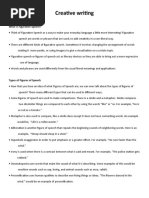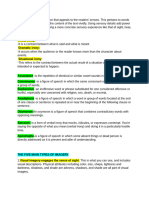0 ratings0% found this document useful (0 votes)
14 viewsCW Reviewer
Creative writing
Uploaded by
kaeCopyright
© © All Rights Reserved
Available Formats
Download as DOCX, PDF, TXT or read online on Scribd
0 ratings0% found this document useful (0 votes)
14 viewsCW Reviewer
Creative writing
Uploaded by
kaeCopyright
© © All Rights Reserved
Available Formats
Download as DOCX, PDF, TXT or read online on Scribd
You are on page 1/ 2
IMAGERY Personification - giving human qualities to
something that may not be human, or even
Imagery is a form of figurative/implied language that alive. example: The flowers nodded their heads
uses objects, actions and ideas in such a way that it cheerfully.
appeals to the senses. It is usually associated with Oxymoron - brings two conflicting ideas
mental pictures or images formed in our minds. together. We use them to draw attention from
1. Visual Imagery - appeals to the sense of sight. It is the reader/listener. Two words with apparently
something that is concrete and can be seen. Example: It contradictory meanings are combined to form a
was dark and dim in the forest. new word that is more in conjunction. example:
alone together
2. Auditory Imagery - appeals to the sense of hearing. Hyperbole - using exaggerated statements for
It is something that you can hear through your mind's effect. example: Jake's mum always cooks
ears. Example: The pattering of the rain is heard against enough food to feed an army.
the window pane. Euphemism - an indirect or innocuous word or
phrase used instead of something considered
3. Olfactory Imagery appeals to the sense of smell. It is
unpleasant, harsh or sensitive, or embarrassing.
something that you can smell through your mind's
example: Friendly fire (attack from allied
nose. Example: The stench of body odor in a crowded
forces). He is telling us a tall story (a lie)
LRT seeped through the fabric of my shirt.
Litotes - an understatement, usually involving a
4. Gustatory Imagery appeals to the sense of taste. It is hint of irony. Instead of saying something
something that you can taste through your mind's simple or obvious, a phrase contrary to the
tongue. Example: Mouth-watering ripe mangoes, truth is used. example: It's hardly rocket
tender melons, and luscious cherries are served on a science is it? (often said when a task is very
tray. simple)
Pun - a play on words as it is usually a jokey
5. Tactile Imagery - appeals to the sense of touch. It is way of exploiting the fact that some words
something that you can touch through your mind's skin. sound alike or have more than one meaning or
Example: The soft velvety feel of silk and satin caressed spelling. example: I've forgotten where my wife
my skin. said we were going, don't worry, Alaska.
Allusion - an implied or indirect reference to a
FIGURES OF SPEECH
person, event or thing from a part of another
Figures of Speech - a form of expression used to convey text. example: that you were romeo you were
meaning or heighten effect often by comparing or drawing pebbles.
identifying one thing with another. Irony - words are used in such a way that theire
intended meaning is different from the actual
- a creative use of language to generate an effect. meaning.
3 Types of Irony
- a phrase that has an implied meaning and should not
1. Verbal irony - a person says one thing but
be taken at face value.
means the opposite. ex: Yay! The weather js
Uses of Figure of Speech: good today (have thunderstorm)
2. Situational irony - when the opposite of
1. Enhance the author's creation. what is expected happens. ex: the police's
house got robbed.
2. Express the author's intent.
3. Dramatic irony - when the audience know
3. They are the palette from which the author works. something that the characters do not.
Paradox - statement that may seem
Different Examples of Figure of Speech contradictory but can be true or make sense.
ex: nobody gets to the restaurant, it's too
Simile - two things are directly compared. We
crowded.
use the word like or as to make the
comparison. example: as cool as a cucumber POETRY
Metaphor - make comparisons between two
dissimilar things, but they do so indirectly Essential Elements of Poetry
without terms like "like" or "as." examples: She
Literary elements are inherent in every genre of
is now in the sunset of her days.
literary piece be it a short story, novel, poetry, and the
like. These elements are extensively employed by
writers in creating their masterpieces to give substance
Alliteration - two usually consecutive words to such literary pieces. In poetry, some of the essential
begin with the same consonant sound but not elements to be conside structure, mood, tone, theme,
always the same letter. example: Peter Piper poetic devices, and rhyme scheme.
picked a peck of pickled peppers.
Structure of Poetry - The structure of a poem • Sonnet -poem consisting of fourteen lines written in
refers to the way it is presented to the reader. iambic pentameter whose Shall I compare thee to a
This may include technical things such as the summer's subject lies mostly about love and nature.
line length and stanza format. Poems are
typically written in the form of stanza. Important elements are rhyme, rhythm and meter.
Stanza - are the poetic equivalent of a prose Rhyme - the repetition of the same stressed
paragraph. These are a series of lines that are vowel sound and any succeeding sounds in two
grouped together and separated from other or more words.
groups of lines or stanzas by a skipped. rhyme scheme - pattern of sounds that repeats
Mood - pertains to the feeling that the reader at the end of a line or stanza. Rhyme schemes
gets from reading. can change line by line, stanza by stanza, or can
Tone - is the author's attitude expressed continue throughout a poem. ex: Edgar Allan
through the word they use. Poe's poem's rhyme scheme is AA-BB-CC-DD-
Theme - universal idea or concept that threads EE-FF-GG
through an entire story. Rhythm - pattern of stressed and unstressed
- note that it is not the same with the moral of beats.
the story. The theme is the UNIVERSAL IDEA Meter - determined by accented (stressed) and
reflected in the poem. When we say unaccented (unstressed) syllables. Silence (or
"universal", it means that it is not only true to pauses) also contributes to a poem's meter.
the poem or to its author, hence, it can be true Scansion is the practice of marking up a poem.
to everyone. 1. Poetic Foot - traditional line of metered
Poetic Devices - help motivate readers' poetry contains a number of rhythmical units
imagination to visualize the characters and called feet.
scenes more clearly. lambic/Iamb meter (unstressed/stressed)
- employed by the writers to give meanings and Trochaic/ Trochee meter (stressed/unstressed)
a framework to their work through language. Spondaic/Spondee meter, (stressed/stressed)
Rhyme Scheme - pattern of rhymes at the end Anapestic/ Anapest meter
of each line of a poem. It is usually referred to (unstressed/unstressed/stressed)
by using letters of the alphabet to indicate Dactylic/Dactyl meter
which lines rhyme. (stressed/unstressed/unstressed)
Conventional Poetry (Traditional Poetic Forms)
• Haiku - A type of poetry which originated from Japan.
5-7-5 syllables per line.
• Tanaga - one stanza poem with 4 lines having 7
syllables each and a rhyming scheme of AAAA.
• Dalit - an offeratory song with eight syllables per lines
and four lines in one stanza and a rhyming scheme of
AAAA
• Diona - Philippine version of Haiku. It is short but it
has measure and rhyme. It is a traditional mono-
rhyming quatrain that consists of seven syllables with
the same rhyme at the end of each line.
• Limerick - humorous poem with five lines that always
have rhyme and meter patterns: Lines 1, 2 and 5 share
the same rhyme and lines 3 and 4 rhyme with each
other.
• Cinquian - form of poetry that is very popular
because of its simplicity. It consists of five lines with
twenty-two (22) syllables, which comes in two, four, six,
eight, and two syllables.
You might also like
- A Guie To Poetry 2024 GRADE 12 POETRY NOTES - GUIDE100% (10)A Guie To Poetry 2024 GRADE 12 POETRY NOTES - GUIDE80 pages
- World Literature Midterm Ang Mga Katabi Ay Gabay Lamang - May Reviewer Gamitin Natin Ito 1 PDFNo ratings yetWorld Literature Midterm Ang Mga Katabi Ay Gabay Lamang - May Reviewer Gamitin Natin Ito 1 PDF6 pages
- A Quick Recap- Poetic Devices, Figures of SpeechNo ratings yetA Quick Recap- Poetic Devices, Figures of Speech18 pages
- Towards An Integral Appreciation of Abhinava's Aesthetics of Rasa100% (1)Towards An Integral Appreciation of Abhinava's Aesthetics of Rasa54 pages
- Now Let No Charitable Hope - Poetry ProfNo ratings yetNow Let No Charitable Hope - Poetry Prof1 page
- Contemporary Literature: Historical OverviewNo ratings yetContemporary Literature: Historical Overview5 pages
- Strategies For Literary Analysis - DIDLS SIFT TPCASTTNo ratings yetStrategies For Literary Analysis - DIDLS SIFT TPCASTT4 pages
- Jaroslav Pelikan - What Has Athens To Do With Jerusalem Timaeus and Genesis in Counterpoint (Thomas Spencer Jerome Lectures) PDF100% (5)Jaroslav Pelikan - What Has Athens To Do With Jerusalem Timaeus and Genesis in Counterpoint (Thomas Spencer Jerome Lectures) PDF156 pages
- Drottkvaett or That Old Norse Poetry Thin-1No ratings yetDrottkvaett or That Old Norse Poetry Thin-112 pages
- The Expert Nature of Wole Soyinka’s Poetry TranslatorsNo ratings yetThe Expert Nature of Wole Soyinka’s Poetry Translators15 pages
- Topic 1: Strategies in Teaching Poetry: University of The Cordilleras College of Teacher EducationNo ratings yetTopic 1: Strategies in Teaching Poetry: University of The Cordilleras College of Teacher Education6 pages

























































































